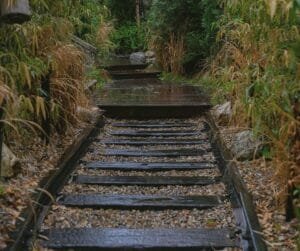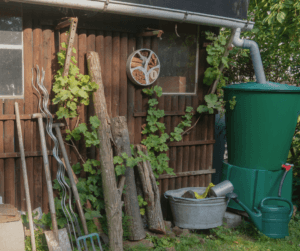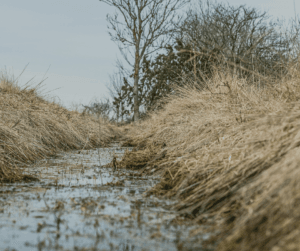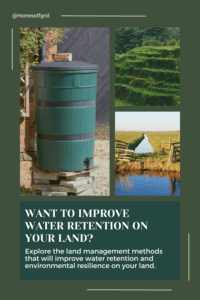Water is one of the most valuable resources on any off-grid property, influencing everything from soil health to food production. Without a reliable water source, maintaining crops, supporting livestock, and sustaining ecosystems becomes significantly more challenging. While many off-grid properties rely on rainfall or natural water bodies, sustainable water retention is key to ensuring long-term viability. This is particularly important in areas prone to drought or unpredictable weather patterns.
Effective water retention strategies allow landowners to make the most of available water, reducing reliance on external sources and improving resilience against dry spells. Retaining water on your land not only enhances soil moisture and plant growth but also prevents erosion, supports biodiversity, and contributes to a more self-sufficient lifestyle. Whether through natural techniques or through engineered solutions, managing water effectively is essential for sustainable land use.
Explore practical and proven methods for optimising water retention on land. Discover natural approaches that work with the landscape, artificial structures designed to enhance water storage, and strategies for assessing and maintaining a successful retention system. By implementing the right combination of techniques, you can create a land management plan that conserves water, supports long-term productivity, and aligns with off-grid living principles.

Understanding Water Retention
Water retention is a fundamental aspect of sustainable land management, directly impacting soil fertility, biodiversity, and long-term productivity. On off-grid land, where access to mains water supplies is limited or non-existent, effectively capturing and storing water can mean the difference between a thriving, self-sufficient landscape and one that struggles with drought and soil degradation.
The Role of Water Retention in Land Sustainability
Sustainable land management relies on the ability to store and use water efficiently. When water is retained effectively, it keeps soil moist for longer periods, reducing the need for additional irrigation. This is particularly valuable for off-grid landowners who depend on natural water sources like rainfall, springs, or collected runoff. By preventing excessive water runoff, landowners can mitigate soil erosion, ensuring that valuable nutrients remain in the ground rather than being washed away.
Beyond supporting plant growth, water retention also helps regulate temperature and humidity within the soil. Moist soils cool the ground during hot weather, reducing heat stress on plants. In colder months, retained moisture can prevent extreme temperature fluctuations that might otherwise harm crops and natural vegetation. The ability to manage water efficiently also promotes long-term land stability, preventing issues such as desertification or salinisation, which can render land unusable over time.
The Ecological Benefits
Beyond its off-grid advantages, water retention plays a crucial role in supporting local ecosystems. By slowing down water movement, retention techniques create microhabitats that encourage biodiversity, from beneficial soil microbes to larger wildlife species. Healthy, moisture-rich soil supports earthworms, fungi, and bacteria that break down organic matter, improving soil fertility and promoting plant health.
Water retention strategies also help recharge groundwater supplies, ensuring that wells, springs, and natural water sources remain viable over the long term. In areas where rainfall is unpredictable, retaining water can mean maintaining a stable water table, reducing the risk of wells running dry. Additionally, wetlands, ponds, and other water retention features provide critical habitats for birds, amphibians, and pollinators, all of which contribute to a balanced and thriving environment.
By understanding the role of water retention in both land sustainability and ecological health, off-grid landowners can make informed decisions about how best to manage their water resources.
Natural Water Retention Techniques
Working with nature is one of the most effective ways to improve water retention on off-grid land. Natural techniques not only help capture and store water but also enhance soil health and resilience. By selecting the right plants, shaping the land to slow runoff, and allowing water to infiltrate the soil more effectively, it is possible to create a landscape that holds onto moisture without relying on artificial irrigation.
Utilising Native Plants
Native plants play a vital role in water retention by adapting to local conditions and requiring minimal intervention. Their deep root systems help stabilise soil, preventing erosion and improving water infiltration. Unlike non-native species, which may struggle in dry periods or require frequent watering, native plants have evolved to withstand the local climate, making them a sustainable choice for off-grid landscapes.
Grasses, shrubs, and trees with extensive root networks create underground channels that allow rainwater to penetrate deeply into the soil rather than running off the surface. This not only increases the amount of moisture stored in the ground but also helps replenish groundwater supplies. In addition, native vegetation supports biodiversity by providing food and shelter for pollinators, birds, and other wildlife. Use websites such as Grow Wild to help identify the most suitable plants to grow in your area.
The Role of Permeable Surfaces
Hard, compacted surfaces such as roads, pathways, and cleared land can cause water to run off too quickly, leading to erosion and water loss. Using permeable surfaces allows rainwater to soak into the ground rather than pooling or running away. Gravel, wood chips, and porous paving materials reduce runoff while helping maintain moisture in the soil.
Healthy soil itself is a permeable surface when well-managed. Adding organic matter through compost or mulch increases soil porosity, improving its ability to absorb and store water. Avoiding excessive soil disturbance and compaction also helps maintain its natural ability to retain moisture.

Harnessing the Power of Swales
Swales are shallow, gently sloped trenches designed to capture and slow down rainwater, allowing it to soak into the ground rather than being lost to runoff. When positioned correctly along the natural contours of the land, they help distribute water evenly across a landscape, preventing erosion and improving soil moisture levels.
Swales can be planted with deep-rooted vegetation to further enhance their water-holding capacity. In drier climates, adding organic matter such as mulch within the swale helps retain moisture for longer. Whether on a small scale in gardens or as part of a larger land management strategy, swales provide an effective and low-maintenance way to improve water retention.
Working With Natural Features for Water Management
Existing land features, such as slopes, valleys, and natural depressions, can be used to direct and retain water effectively. Instead of fighting the natural flow of water, working with the landscape ensures that rainfall is captured where it is needed most. Small earthworks, such as terraces or contour planting, slow water movement and encourage infiltration.
Woodlands, hedgerows, and natural wetlands also contribute to water retention by reducing wind exposure, shading the soil, and acting as natural sponges that hold onto moisture. Protecting and enhancing these features can lead to a more resilient, self-sustaining environment.
Natural water retention techniques are an essential part of sustainable land management. By using native plants, shaping the land carefully, and encouraging water infiltration, it is possible to build a landscape that holds onto moisture, supports biodiversity, and remains productive even in challenging conditions.
Artificial Water Retention Structures
While natural techniques form the foundation of sustainable water retention, artificial structures can significantly enhance a land’s ability to capture and store water. These engineered solutions help slow runoff, prevent soil erosion, and make water available during dry periods. By strategically implementing artificial retention features, landowners can create a more resilient and self-sufficient water management system.
The Importance of Bunds and Berms
Bunds and berms are simple yet effective structures for managing water flow and improving retention. A bund is a raised barrier, often made of soil, that directs and slows water movement. Berms are similar but typically broader and can be used to create terraces or raised planting areas. Both features work by capturing water that would otherwise run off too quickly, allowing it to infiltrate the soil.
On sloped land, bunds and berms prevent erosion by breaking up the flow of water and spreading it more evenly across the surface. They can be particularly useful in combination with swales, where they reinforce natural water retention efforts. For maximum effectiveness, they should be positioned to follow the land’s natural contours, ensuring that water is directed to areas where it is most needed.
Implementing Rain Gardens
A rain garden is a shallow, planted depression designed to capture and filter rainwater runoff. These gardens allow water to slowly percolate into the soil, reducing surface runoff and preventing flooding in low-lying areas. By incorporating deep-rooted plants, rain gardens enhance absorption, improve soil structure, and provide valuable habitats for pollinators and beneficial insects.
Rain gardens are particularly effective in areas where excess water accumulates, such as near roofs, driveways, or other impermeable surfaces. They also help filter out pollutants before water re-enters the groundwater system, making them a beneficial addition to any off-grid land where water quality is a concern.
Rainwater Harvesting Systems
Harvesting rainwater is one of the most direct ways to increase water availability on off-grid land. Systems range from simple rain barrels to large underground storage tanks, collecting water from rooftops or other surfaces for later use. This reduces reliance on natural water sources and ensures a backup supply during dry spells.
A well-designed rainwater harvesting system includes gutters, downpipes, and filters to direct and clean the collected water. Stored water can be used for irrigation, household needs, or even drinking with the right purification methods. Integrating rainwater harvesting with other retention strategies, such as swales or rain gardens, further enhances its effectiveness.

The Science of Retention Ponds
Retention ponds are artificial basins designed to collect and store water over long periods, preventing excessive runoff and helping to regulate groundwater levels. Unlike traditional ponds, retention ponds are specifically designed to hold water even during dry spells, making them a reliable feature for off-grid landowners seeking long-term water security.
By capturing stormwater, retention ponds reduce flooding risk and help replenish local aquifers. They also create valuable ecosystems, supporting aquatic plants and wildlife while improving overall biodiversity. When properly managed, these ponds contribute to a balanced water cycle, ensuring that water remains available for irrigation and other uses.
Artificial water retention structures provide practical solutions for increasing water availability and stability on off-grid land. Combining these techniques with natural retention strategies ensures a well-rounded approach to water management, creating a landscape that is both productive and resilient.
Designing Your Water Retention Strategy
Creating an effective water retention strategy requires a tailored approach that considers the land’s natural characteristics, functionality, and long-term sustainability. By assessing the terrain, integrating both natural and artificial retention methods, and planning for seasonal variations, landowners can develop a system that efficiently captures and stores water while enhancing the overall landscape.
Assessing Your Land for Water Retention Potential
Before implementing any water retention techniques, it is essential to evaluate the land’s natural water flow, soil composition, and topography. Identifying high and low points, drainage patterns, and areas prone to erosion helps determine the most effective placement for retention structures.
Key factors to assess include:
- Soil type: Sandy soils drain quickly, while clay-heavy soils retain more moisture. Altering the soil composition with organic matter can improve its water-holding capacity.
- Slope and elevation: Steeper slopes increase runoff, making bunds, berms, and terraces essential for slowing water movement.
- Existing vegetation: Native plants with deep root systems stabilise soil and improve infiltration, while areas with exposed soil may require erosion control measures.
- Water sources and runoff patterns: Observing how water moves across the land during rainfall can highlight areas where retention structures, such as swales or ponds, would be most beneficial.
Conducting a thorough assessment ensures that any water retention efforts work in harmony with the landscape rather than against it.
Balancing Aesthetics with Functionality
A well-designed water retention system should not only be practical but also complement the natural beauty of the land. Thoughtful integration of water features, planting schemes, and structural elements can enhance both the visual appeal and ecological health of the property.
- Blending structures with the environment: Berms and bunds can be planted with native grasses and shrubs to create a natural appearance while improving stability.
- Incorporating multi-purpose features: A retention pond can serve as a water source, wildlife habitat, and an attractive focal point within the landscape.
- Using varied textures and plant life: Rain gardens, permeable pathways, and well-placed rock features add both visual interest and functionality to a water management plan.
By designing with both form and function in mind, a water retention system can become an integral part of a self-sufficient and aesthetically pleasing off-grid property.
Seasonal Considerations and Maintenance
Water retention strategies must be adaptable to seasonal changes to remain effective year-round. Planning for periods of heavy rainfall, drought, and freezing temperatures helps ensure that the system continues to function efficiently.
- Winter preparations: In colder climates, retention ponds may freeze, and water storage systems should be insulated to prevent damage. Ensuring adequate drainage can help prevent ice buildup in swales and berms.
- Managing excess water in wet seasons: Overflow channels, spillways, and proper drainage prevent waterlogging and soil erosion during heavy rains.
- Drought resilience: Mulching, deep-rooted vegetation, and proper soil management improve water retention during dry spells, reducing the need for supplemental watering.
- Regular maintenance: Checking for erosion, clearing debris from swales and rain gardens, and ensuring storage tanks remain clean and functional will keep the system in good working order.
A well-planned water retention strategy accounts for seasonal shifts, allowing landowners to maintain a stable water supply while protecting the health of their land. By assessing the landscape, integrating both practical and visually appealing elements, and planning for seasonal changes, it is possible to create a water retention system that is both efficient and sustainable.

Sustainable Land Management
Effective water retention is more than just a strategy for improving water availability – it plays a key role in sustainable land management. By integrating water retention techniques into broader land stewardship practices, landowners can promote self-sufficiency, reduce environmental impact, and build long-term resilience against climate variability.
Promoting Self-Sufficiency and Sustainability
Water retention systems contribute to a more self-sufficient and sustainable lifestyle by reducing dependence on external water sources and enhancing natural water cycles. By capturing, storing, and effectively utilising water, landowners can ensure reliable access to this essential resource, even in dry periods.
Key benefits include:
- Improved crop and livestock resilience: Retained water supports consistent irrigation and provides drinking water for animals, reducing the need for costly external water sources.
- Enhanced soil health: Retention techniques such as swales, mulching, and rain gardens prevent soil degradation, increasing its fertility and water-holding capacity over time.
- Reduced reliance on municipal or borehole water: By harvesting and managing rainfall efficiently, landowners can lessen their dependence on additional water supplies.
When designed thoughtfully, water retention systems work in harmony with the land, creating a more self-sustaining environment that requires less intervention and external input.
Reducing Environmental Impact
Sustainable water management also helps minimise environmental degradation by preventing erosion, reducing pollution, and maintaining natural hydrological cycles. Water retention techniques slow runoff, allowing water to infiltrate the soil rather than being lost to evaporation or flowing into waterways carrying sediment and contaminants.
Ways that water retention reduces environmental impact include:
- Preventing soil erosion: By slowing water movement, features like bunds, berms, and vegetative cover prevent valuable topsoil from being washed away.
- Minimising pollution runoff: Retention ponds and rain gardens filter out pollutants before they reach streams and groundwater, improving overall water quality.
- Supporting biodiversity: Wetland areas, retention ponds, and carefully managed water landscapes provide habitat for pollinators, amphibians, and other wildlife.
By reducing erosion, managing runoff responsibly, and preserving natural ecosystems, sustainable water retention supports a balanced and thriving environment.
Building Resilience in Land Management
Resilience is a crucial aspect of sustainable land management, particularly in regions prone to droughts, heavy rains, or unpredictable climate patterns. Implementing long-term water retention strategies helps landowners adapt to changing conditions while maintaining productivity.
Resilient water management includes:
- Diversified water sources: Combining multiple water retention methods – such as ponds, rainwater harvesting, and soil moisture management – ensures reliable access to water throughout the year.
- Drought and flood mitigation: Retention structures slow and store excess water during heavy rains, preventing flooding, while deep infiltration and soil improvement increase drought resistance.
- Flexible land use strategies: Integrating water retention into rotational grazing, permaculture, and agroforestry systems enhances the land’s ability to recover from environmental stressors.
A well-designed water retention system strengthens land management efforts by ensuring that water remains available and usable, even in the face of environmental challenges.
By promoting self-sufficiency, reducing ecological impact, and enhancing land resilience, sustainable water retention becomes a cornerstone of responsible and productive land management.
Conclusion
Effective water retention is essential for sustainable land management. It ensures a reliable water supply while improving soil health, reducing environmental impact, and increasing resilience. By understanding natural water flow and incorporating a mix of natural and artificial retention methods, landowners can create a system that captures and stores water efficiently. Techniques such as swales, mulching, and deep-rooted vegetation enhance infiltration and soil structure. Meanwhile, artificial solutions like bunds, rain gardens, and retention ponds help prevent erosion and manage runoff.
A well-designed water retention system balances aesthetics with functionality, integrating seamlessly into the landscape while providing long-term benefits. Seasonal considerations, including preparations for heavy rain, drought, and freezing temperatures, ensure that retention methods remain effective throughout the year. With thoughtful planning and regular maintenance, these strategies contribute to greater self-sufficiency and a more ecologically balanced environment.
By implementing sustainable water management practices, landowners can protect their land, support biodiversity, and reduce reliance on external resources. Whether on a small homestead or a larger property, every step toward improving water retention strengthens the land’s ability to thrive. Working with nature rather than against it allows for a productive, resilient, and self-sustaining landscape for years to come.

To find out more about off-grid living return to our Reading Room.


